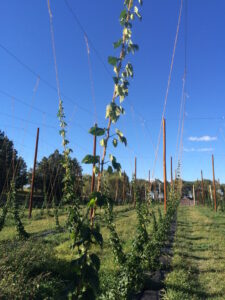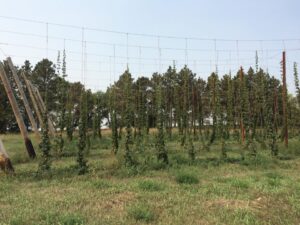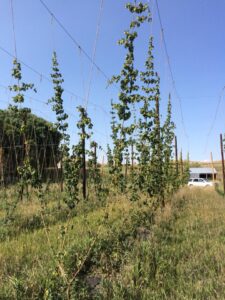Project Overview
Annual Reports
Commodities
- Agronomic: hops
Practices
- Crop Production: cover crops
- Farm Business Management: farm-to-institution, feasibility study
- Production Systems: general crop production
- Sustainable Communities: new business opportunities
Summary:

I installed two hops trellises in different soil types, sandy and loamy, to ascertain with soil type is superior for hops production. I also planted eight different varieties, again to determine what kind of hops grow best here. To determine the results, I weighed the harvested cones and had the oil content measured by a lab. I then compared the results.
Unfortunately, I had a late frost in the end of May at the time the bines where ready to be trained to the twine. This frost set the plants back a month. Due to this, the harvest was small and oil contents were impacted. Thus, the results of this inquiry must be interpreted with this in mind.
Despite this setback, I did learn much from this experiment. I found that Cascade, Centennial, and Triple Perle, and Chinook hops were the most productive of the varieties; in that order. These varieties are American hybrids and produce more pounds than aromatic varieties. However, even with this considered, these hybrids did outperform the other varieties.
In regards to soil type, all varieties produced better at the sandy plot than the loamy soil plot, except for one variety, Triple Perle. I predict that this is due to the better drainage of the sand. While hops do require approximately a gallon of water per plant per day, the roots do not like to sit in overly saturated soil. Hops growers refer to this as "hops don't like wet feet". Aside from this generalization, it is interesting that the Triple Perle did much better at the loamy soil plot. I have no theories to explain this, I am assuming that this newly developed hops varietal just simply grows better in loamy soil. While all oil contents were low, the Chinook was higher at the loamy plot.
With this information, I have decided to plant Chinook in sandy soil for my next acre. While other varieties did perform marginally better, my brewers have expressed a higher desire for Chinook than the other American hybrids I am currently producing. I am hoping I have better weather this coming season and can obtain more robust data for comparison. My plants will be fully mature and I am hoping the aromatics perform better given that they are worth more per pound. While planting my next acre with Chinook that I know performs well, I have not dismissed the possibility of raising aromatics.
Project objectives:
My objective for this project was to examine the difference in hops production of different varieties in two different soil types. The varieties of hops planted are: Cascade, Cashmere, Chinook, Centennial, Triple Perle, Nugget, Yakima Gold, and Hallertauer. I planted these in two test plots, in sandy and loamy soil. I will use the results of the productivity of these plots to assist me in making decisions on new plot placement and varieties planted. I will distribute this information to other potential and established hops farmers through the iGrow website and the South Dakota Hops Growers Association. I believe that hops farming in South Dakota is an opportunity for more people to enter agriculture, or diversity their current operations on a relatively small amount of acreage. Brewers in the state will also benefit by being able to produce and market a locally sourced beer.

 Hines_FNC16-1036Budgetok
Hines_FNC16-1036Budgetok